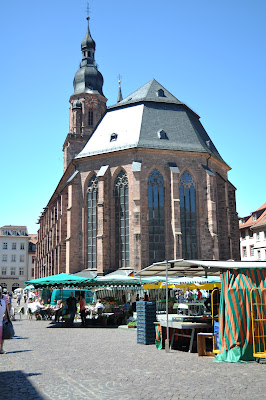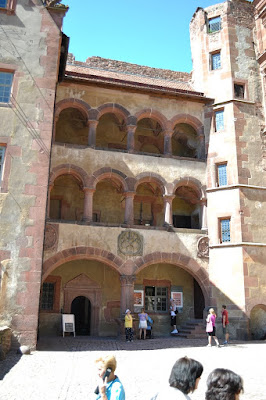I always want to visit Germany which is my favorite european country because of my favorite author. She married a German and lives in Germany. From her book, I learned a lot about Germany. So it's a wonderful opportunity to live here for few years. Of course we are going to tour around the country and the whole Europe also.
I've got on line trying to find some information about Haidelberg. There are lots of place to see. But we didn't have enough time to see everything. Still, it's a wonderful trip.

Market Square
A fountain with a statue of Hercules on a column, built between 1703 and 1706, forms the centerpiece of the Market Square. This hero of Greek myths, known for his strength, symbolizes the heroic efforts that Heidelberg’s residents made to rebuild their devastated city in the years after 1700.
The Hercules statue in the fountain today is a replica, however; the original is in safekeeping in the Kurpfälzisches Mu-seum. Twice a week an open-air market takes place in the Market Square. The rest of the time – during the warm months of the year – it holds several outdoor cafés.
Heiliggeistkirche (Church of the Holy Spirit)

Biggest regional Gothic Church
Short introduction: The Heiliggeistkirche (Holy Ghost Church) was built from 1344 to 1441, its tower completed in 1544. It was the burial place of 55 Prince Electors and hosted the famous Bibliotheca Palatina until 1623.
Detailed history:
A late Roman basilica was first mentioned in 1239. In 1398, it was replaced by a large church building which nave was constructed in the typical style of the late Gothic period. The chancel was completed by 1410, the building of the nave took until 1441. There was also a delay in the construction of the church tower which was started again in 1508. The chancel contained the tombs of the Prince Electors of the Palatinate. Most of the commemorial tablets were destroyed in 1693. Of the originally 54 epitaphs, the only one to remain was the one of Prince Elector Ruprecht II (1352 - 1410).
During the 30 Year´s War, however, the complete collection became the booty of Heidelberg´s conqueror, commander Tilly. Following orders of the Catholic Prince Elector Maximilian of Bavaria, the library was given to the Pope of Rome. Of the collection which once included more than 5000 books and 3524 manuscripts, only 885 manuscripts were returned to Heidelberg in 1816. During the following centuries, the church frequently changed its religious denomination and was used at different times by Catholics as well as Protestants. Even a partition barrier was erected in 1706 because both denominations wanted to hold service here. For 230 years, the barrier stayed in its place until it was removed in 1936. Today, the Church of the Holy Spirit is a Protestant Church.
Heidelberg Castle is one of the Germany's most important cultural monuments. It experienced a grand and eventful history as the royal seat of the Electors of the Palatinate from the 13th to the 18th century. Over the centuries the bustling building activity of the Palgraves resulted in an ensemble of representative palace and garden art with great artistic achievements in the style of the Renaissance.
Following the destruction of the palace in the War of Palatinate Succession (1688-1697), Electors Johann Wilhelm, Karl Philipp and Karl Theodor carried out various restoration measures, although the royal seat had been moved to Mannheim beginning in 1720. A lightning strike in 1764 and the major fire that followed once again reduced the palace to ashes. Since the 19th century Heidelberg has been famous the world over for the romantic appearance of its palace ruins.
Alte Brücke (Old Bridge)The four preceeding bridges were wooden constructions. Again and again they were destroyed by floods, fire and ice. Prince Elector Karl Theodor was the first ruler to have construct a stone bridge which was erected here from 1786 to 1788. Well preserved is the medieval bridge gate on the town side, originally part of the town wall. Baroque tower helmets were added during the erection of the stone bridge in 1788. Also located here is a plaque referring to the defence of Heidelberg against French troops.
On October 16, 1798, a brave Austrian regiment commanded by Prince Schwarzenberg succeeded in repulsing the advancing French Army. The West Tower contains dungeons, whereas the East Tower holds a spiral staircase. A few steps east of it visitors will find the "Tränktor" (Drinking Gate). During the Middle Ages, cattle were driven through this gate to their drinking places. The two bays of the bridge carry monuments created by Franz Konrad Linck (1730 - 1793) who, since 1763, was the Prince Elector´s official court sculpturist.
entrance of the castle garden






























No comments:
Post a Comment